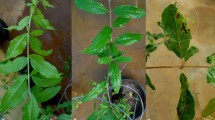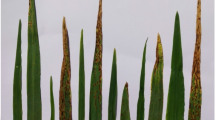Abstract
Tea (Camellia sinensis) plantations are exposed to biotic and abiotic stresses. Among the biotic factors, blister blight (BB), caused by Exobasidium vexans, affects the quality and quantity of the product and demands high fungicide application. A long term solution for disease resistance would require the knowledge of the basic molecular and biochemical changes occurring in plant as an attempt to resist the pathogen and limit the spread of the disease which can further help in developing resistant cultivars using biotechnological tools. Thus, gene expression studies using the cDNA based suppressive subtractive hybridization library, characterization of genes for pathogenesis related (PR) proteins [chitinase (CsCHIT), glucanase (CsGLUC), phenylalanine ammonia lyase (CsPAL)] and genes in flavonoid pathway were accessed in the BB resistant and susceptible cultivars, SA6 and TES34, respectively. Further, biochemical analysis of PR and antioxidant enzymes (POX, APX, SOD) involved in BB resistance have been carried out to investigate the potential molecular and biochemical changes. Various stages of pathogen development had varied impact on PR protein, flavonoid pathway and anti-oxidative enzymes and indicates the possible role of reactive oxygen species, lignins, flavonoids, anthocyanins and other synthesized compounds in acting as antimicrobial/antifungal agents in tea cultivars.






Similar content being viewed by others
References
Baby UI (2006) Varietal resistance of certain south Indian tea clones to blister blight. Annual Reports of UPASI, Coimbatore, p 2
Balasubramanian V, Vashisht D, Cletus J, Sakthivel N (2012) Plant β-1,3-glucanases: their biological functions and transgenic expression against phytopathogenic fungi. Biotechnol Lett 34(11):1983–1990
Bradford MM (1976) A rapid and sensitive method for the quantification of microgram quantities of protein utilizing the principle of protein—dye binding. Anal Biochem 72:248–254
Carlsen SCK, Understrup A, Fomsgaard IS, Mortensen AG, Ravnskov S (2008) Flavonoids in roots of white clover: interaction of arbuscular mycorrhizal fungi and a pathogenic fungus. Plant Soil 302:33–43
Chakraborty U, Chakraborty N (2005) Impact of environmental factors on infestation of tea leaves by Helopeltis theivora and associated changes in flavonoid flavor components and enzyme activities. Phyto Parasit 33:88–96
Cramer CL, Bell JN, Ryder TB, Bailey JA, Schuch W, Bolwell GP et al (1985) Coordinated synthesis of phytoalexin biosynthetic enzymes in biologically-stressed cells of bean (Phaseolus vulgaris L.). EMBO J 4:285–289
Foster-Hartnett D, Danesh D, Peñuela S, Sharopova N, Endre G, Vandenbosch KA, Young ND, Samac DA (2007) Molecular and cytological responses of Medicago truncatula to Erysiphe pisi. Mol Plant Path 8:307–319
Gnanamangai BM, Ponmurugan P, Yazhini R, Pragadeesh SK (2011) PR Enzyme activities of Cercospora theae causing Bird’s eye spot disease in tea plants (Camellia sinensis (L) O Kuntze). Plant Path J 10:13–21
Indramani B, Bishwanath C (2010) Defense response triggered by Sclerotium rolfsii in tea plants. Ecoprint 17:69–76
Miranda M, Ralph SG, Mellway R, White R, Heath MC, Bohlmann J et al (2007) The transcriptional response of hybrid poplar (Populus trichocarpa × P deltoides) to infection by Melampsora medusae leaf rust involves induction of flavonoid pathway genes leading to the accumulation of proanthocyanidins. Mol Plant Microb Int 20:816–831
Mittler R, Herr EH, Orvar BL, Van Camp W, Willekens H, Inze D, Ellis BE (1999) Transgenic tobacco plants with reduced capability to detoxify reactive oxygen intermediates are hyper responsive to pathogen infection. Proc Nat Acad Sci USA 96:14165–14170
Palanisamy S, Mandal AK (2014) Susceptibility against grey blight disease-causing fungus Pestalotiopsis sp. in tea (Camellia sinensis (L.) O. Kuntze) cultivars is influenced by anti-oxidative enzymes. Appl Biochem Biotechnol 172(1):216–223
Pan SQ, Ye XS, Kuc J (1991) Association of β-1,3-glucanase activity and isoform pattern with systemic resistance to blue mould in tobacco induced by stem injection with Peronospora tabacina or leaf inoculation with tobacco mosaic virus. Physiol Mol Plant Pathol 39:25–39
Provart NJ, Gil P, Chen W, Han B, Chang HS, Wang X, Zhu T (2003) Gene expression phenotypes of Arabidopsis associated with sensitivity to low temperatures. Plant Physiol 132:893–906
Punyasiri PAN, Tanner GJ, Abeysinghe SB, Kumar V, Campbell PM, Pradeepa NHL (2004) Exobasidium vexans infection of Camellia sinensis increased 2,3-cis isomerization and gallate esterification of proanthocyanidins. Phytochem 65:2987–2994
Radomiljac JD, Whelan J, van der Merwe M (2013) Coordinating metabolite changes with our perception of plant abiotic stress responses: emerging views revealed by integrative—omic analyses. Metabolites 3:761–786
Rajalakshmi N, Ramarethinam S (2000) The role of Exobasidium vexans in flavonoid synthesis Camellia assamica. J Plant Crops 28:19–29
Recupero GR, Gentile A, Russo MP, Domina F (1997) Genetic analysis of resistance to Phoma tracheiphila in three Citrus and Poncirus progenies. Theor Appl Genet 116:198–200
Rybka K, Arseniuk E, Wisniewska J, Bojanowska KR (1998) Comparative studies on the activities of chitinase, β 1,3-glucanase, peroxidase and phenylalanine ammonia lyase in the leaves of triticale and wheat infected with Stagonospora nodorum. Acta Physiol Plant 20:59–66
Sadasivam S, Manickam A (1996) Biochemical methods. New Age International (P) Limited, Chennai, pp. 190–191
Senthilkumar P, Thirugnanasambantham K, Mandal AKA (2012) Suppressive subtractive hybridization approach revealed differential expression of hypersensitive response and reactive oxygen species production genes in tea (Camellia sinensis (L.) O. Kuntze) leaves during Pestalotiopsis thea infection. Appl Biochem Biotechnol 168:1917–1927
Singh HR, Deka M, Das S (2015) Enhanced resistance to blister blight in transgenic tea (Camellia sinensis [L.] O. Kuntze) by overexpression of class I chitinase gene from potato (Solanum tuberosum). Funct Int Genom 15:461–480
Sun Y, Liu W, Han B, Zhang J, Liu B (2006) Purification and characterization of two types of chitosanase from a Microbacterium sp. Biotechnol Lett 28:1393–1399
Thimmapuram J, Ko TS, Korban SS (2001) Characterization and expression of β-1,3 glucanase genes in peach. Mol Genet Genom 265:469–479
Thirugnanasambantham K, Prabu GR, Senthilkumar P, Suresh Ramraj SC, Mandal AKA (2011) Identification of differentially expressed genes in dormant (banjhi) bud of tea (Camellia sinensis (L.) O. Kuntze) using subtractive hybridization approach. Plant Physiol Biochem 49:565–571
Tretter L, Adam-Vizi V (2005) Alpha-ketoglutarate dehydrogenase: a target and generator of oxidative stress. Philos Trans R Soc B 360:2335–2345
Vogeli-Lange R, Hansen-Gehri A, Boller T, Meins F Jr (1988) Induction of the defense-related glucanohydrolases, β-1 → 3-glucanase and chitinase, by tobacco mosaic virus infection of tobacco leaves. Plant Sci 54:171–176
Widjaja I, Naumann K, Roth U, Wolf N, Mackey D, Dangl JL et al (2009) Combining subproteome enrichment and RUBISCO depletion enables identification of low abundance proteins differentially regulated during plant defense. Proteomics 9:138–147
Ying W (2008) NAD+/NADH and NADP+/NADPH in cellular functions and cell death: regulation and biological consequences. Antioxid Redox Signal 10:179–206
Zwerger K, Hirt H (2001) Recent advances in plant MAP kinase signalling. Biol Chem 382:1123–1131
Acknowledgements
This study was financially supported by Tea Board, Kolkata, India under the XI five year plan.
Author information
Authors and Affiliations
Corresponding author
Ethics declarations
Conflict of interest
The authors declare that they have no conflict of interest.
Electronic supplementary material
Below is the link to the electronic supplementary material.
Rights and permissions
About this article
Cite this article
Nisha, S.N., Prabu, G. & Mandal, A.K.A. Biochemical and molecular studies on the resistance mechanisms in tea [Camellia sinensis (L.) O. Kuntze] against blister blight disease. Physiol Mol Biol Plants 24, 867–880 (2018). https://doi.org/10.1007/s12298-018-0565-9
Received:
Revised:
Accepted:
Published:
Issue Date:
DOI: https://doi.org/10.1007/s12298-018-0565-9




